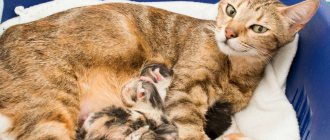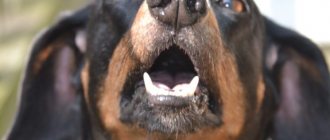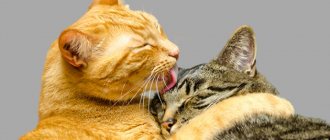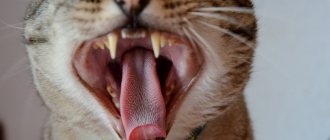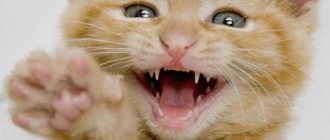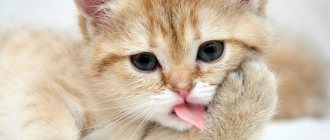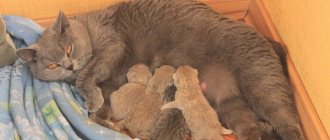Why does a cat breathe with its mouth open?
One of the possible signs of severe complications is when the cat is breathing with its mouth open.
Cats differ from dogs not only in external characteristics, but also in the process of thermoregulation. Thus, dogs, when their body temperature rises, begin to stick out their tongue, thereby increasing the total area of moisture evaporation. Cats do not have this property, so frequent breathing in cats is a sign of the development of pathology. The process of giving birth to kittens is a difficult period in the life of cats. In addition, the danger of childbirth lies in the possible infection of the birth canal with infectious agents - pathogenic bacterial cultures. In some cases, the cause of postpartum complications is a difficult birth with injuries.
Prolonged open-mouth breathing in cats indicates a complication or stress. In such cases, you cannot do without consultation and examination by a veterinary specialist. One of the main reasons for rapid breathing in cats after birth is severe stress. This is especially evident in primiparous young cats. In a state of nervousness and shock, the new mother may abandon the kittens or even eat them.
Other conditions that are life-threatening for the animal are:
- delay in leaving the child's seat;
- inflammatory processes in the mammary glands;
- milk tetany.
It is necessary to contact a veterinary clinic or call a veterinarian to your home as soon as the animal lambs. This will help to avoid possible complications in the future and will allow you to monitor the condition of your pet.
Veterinarians recommend performing thermometry in cats for seven days after birth. Such measurements should be carried out rectally once a day. A rise in temperature of more than 39.6 degrees requires mandatory contact with a qualified specialist.
Eclampsia or milk fever are the names of one of the most dangerous complications in cats that develop after the birth process. The main reason for the development of this pathology is an acute lack of calcium in the blood. A sharp decrease in calcium in the blood plasma causes convulsions, rapid breathing, the appearance of fear and causeless anxiety, stretching of the neck, and in some cases, foam at the mouth.
It is worth noting that it is not recommended to exceed the recommended doses of calcium during a cat’s pregnancy. Positive results cannot be achieved with this approach, but the situation can worsen. The fact is that an excessive amount of calcium is not absorbed and processed by the body, and in addition, the compensatory functions of the body cease to absorb even the usual normal doses of the microelement.
The pathology that occurs in cats that have given birth, manifested as an inflammatory process in the milk ducts, is called mastitis. The main signs are an increase in the milk lobes in volume, severe swelling, hyperemia and pain. The cat's body temperature rises, causing the cat to hyperventilate. The main cause of mastitis is infection of the mammary glands by pathogenic microorganisms.
• hormonal imbalances; • hypothermia and drafts; • weak sucking reflex in kittens.
It is extremely important to carry out timely diagnosis of the whole body after birth and prenatal prevention in order to avoid possible consequences, preserving the health of your pet and her kittens. You need to carefully monitor the general condition of the cat and call your veterinarian at the slightest deviation from the norm.
In general, the development of mild shortness of breath immediately during and after the birth of kittens is completely normal, and in most cases there is nothing to worry about. Why does this happen? As you might guess, during childbirth a cat’s body experiences enormous stress and overload, exceeding those of marathon athletes. Even trained athletes or racehorses breathe heavily after this, what can we say about a cat that has just given birth!
First, we need to talk again about the hardships of pregnancy (especially in cases of large and multiple pregnancies). If there are many kittens in the uterus, or they are large, the organ increases in size very, very much. Sometimes so much so that the cat’s belly hangs almost to the ground. The swollen uterus strongly compresses not only other organs of the abdominal and pelvic cavities, but also the lungs, pressing on them from the side of the diaphragmatic dome.
Of course, this is not in vain for the organs of the respiratory system. In particularly severe cases, you may notice signs that something is wrong even during pregnancy, when the cat cannot even walk to the food bowl without immediately developing severe shortness of breath. Unfortunately, nothing can be done about this. We can only recommend maintaining optimal temperature and humidity in the room where the cat spends most of its time.
But it’s much worse if the cat is already old. In this case, simple shortness of breath will probably not solve the problem. It's all about anatomy and physiology. If the lungs are compressed by the enlarged uterus and other organs of the abdominal and pelvic cavities, blood circulation in the pulmonary circle will be greatly hampered. This will lead to an increase in blood pressure in the vessels... of course, it cannot increase constantly.
Its characteristic signs are shortness of breath, when the animal breathes strained and frequently while sitting with its mouth open. In severe cases, the cat coughs violently, causing lumps of white, flaky foam to come out of its mouth. If you see something like this in a pet that has given birth, call a veterinarian immediately. Delay may result in the cat’s death from hypoxia (suffocation). Lungs filled with foam simply will not be able to provide the body with oxygen.
Postpartum cat care
After a cat has given birth on its own, few people know how to properly care for it. For 12 days after giving birth, small blood clots may still ooze from the cat’s vulva, but the animal takes care of its hygiene on its own. Gradually the discharge will become lighter and stop altogether.
Note! If the animal is sick or has given birth for the first time, then the owner will have to care for her. You need to take a warm, damp towel and wipe the vulva, abdomen and thighs to remove dirt.
From time to time it is necessary to change the dirty litter under the kittens and the cat with clean ones. This should be done when the mustachioed mother has gone to the toilet or gone to eat, so as not to disturb her again. If you are constantly near the offspring, then she may begin to hide the kittens in another place where it is more secluded.
It is important to monitor the condition of the mammary glands so that they are not inflamed or cracked, because as any disease progresses, the offspring will have to be supplemented by hand.
The cat takes care of the kittens, but if it is weakened, then the owner will have to take on some of the worries.
Many owners are interested in the question of what to do with kittens after birth. Since kittens are born blind, it is worth taking care that they are not irritated by bright light. After a cat has chewed the umbilical cord, it should be treated with brilliant green for speedy healing. It is important to monitor the feeding of babies so that their mouth tightly grasps the nipple.
Child seat exit delay
The basic sign of this pathology is a sharp rise in body temperature and frequent, sometimes heavy breathing with an open mouth. The cat shows anxiety and may begin to drag newborn babies from the box to other places. In addition, the cat does not want to drink water or eat food. State of depression and depression.
It is advisable to write down their number so as not to miscalculate later, since cats usually eat their afterbirth. A failed placenta is an alarming sign that threatens complications and the development of inflammatory processes in the uterus. Often, delayed placenta becomes the cause of sepsis - blood poisoning.
It is noteworthy that when conducting an ultrasound examination there is no guarantee of detection of the placenta. This is due, first of all, to the size of the uterus, which remains enlarged for some time after birth and may contain blood clots that are mistakenly taken for the placenta that has not been delivered.
Having established the cause of the cat's anxiety, frequent breathing with an open mouth due to retained placenta, conservative therapy is carried out. It consists of taking specific medications that expel the placenta from the uterine cavity. If there is no effect of drug treatment, the uterus and appendages are removed.
What to do if maternal instinct is violated
Maternal instinct in cats may not begin to manifest itself in cats from the first days, especially if she is a primigravida. Also, stress, hormonal and genetic disorders are the cause of poor maternal instinct.
In addition, after a caesarean section, the instinct of motherhood may manifest itself weakly or not at all. Very often the person is to blame for this, because after giving birth he is constantly near the kittens, pushing them out of the box, making noise, picking them up, etc. This should not be done under any circumstances.
Heart pathologies
A very large group of diseases. Pregnant cats most often develop dilated cardiomyopathy. Without going into details, this is the name for an increase in the size of the heart with simultaneous thinning of its walls. Often the disease is one of the consequences of the condition described above.
This is especially true for older cats. Constant pregnancy and the stress experienced by the body during this period lead to severe stretching of the heart muscle. She can no longer pump blood normally through the pulmonary circulation... as a result of which the same pulmonary edema develops.
Remember that at the slightest suspicion of heart pathology, you should immediately call a veterinarian! If a specialist confirms the presence of cardiomyopathy, the cat will be prescribed treatment... Most likely, lifelong. In addition, we would strongly advise such animals to be sterilized without fail, since their body will most likely not be able to withstand subsequent pregnancies.
Thus, we need to take stock. As a rule, heavy and rapid breathing with an open mouth, observed in a cat immediately after birth, can be (at least partly) considered normal. But in cases where this condition is observed for three or more hours, it does not hurt to call a veterinarian. Perhaps in this way you will save your pet's life.
Veterinarians emphasize that a normal pulse in cats and breathing rate are indicators of good health. A significant excess of the norm, not caused by the influence of stress factors, serves as a signal for hospitalization of the animal. If your cat is choking or showing signs of a heart attack, your pet needs help at home.
Nutrition during the postpartum period
After giving birth, it is necessary to give the animal milk, cottage cheese and sour cream, that is, foods rich in calcium. If the body does not have enough of this element, then the pet’s general health may deteriorate, convulsions and postpartum eclampsia may appear.
A cat should eat a variety of foods: meat, fish, chicken eggs. An important source of vitamins is greens, which should also be finely chopped and added to food. If the animal refuses to eat it, then there is no need to force it in, but it is better to purchase special vitamin complexes at the pharmacy.
Nutrition for a mustachioed mother is especially important during this period
For your information! You should definitely increase the amount of fluid you drink. The cat should drink water and also eat soups, broths, etc. The two meals a day should be increased to six times and given in small portions so that the cat has regular milk production.
Breathing assessment
This can be done by observation, counting the number of inhalations and exhalations in 30 seconds and multiplying this number by 2. Cats take between 20 and 40 breaths per minute. In this case, you should keep in mind the age and gender of the animal. Kittens breathe more often than adult animals, cats breathe more often than cats, pregnant, lactating and medium-sized cats also breathe more often.
In addition, a cat's breathing becomes more frequent in a state of excitement, increased activity, or in hot weather. If a cat's respiratory rate is above 40 per minute, observed for a long time and not caused by any of the factors listed above, this is a sign of ill health.
Prevention of complications
To avoid health complications, it is necessary to provide proper care for your cat in advance: clean diapers, boiled water and cotton swabs. It is very important to find a place for lambing, especially if it is a Scottish cat who does not like when any of the people are nearby, he begins to meow and look for a secluded place.
Before giving birth, it is imperative to feed the animal correctly and in a balanced manner so that it is strong and healthy, and then the birth will be quick and easy. It is important to remember that kittens must be born in a sterile environment so that the infection does not penetrate the uterus and cause complications for the new mustachioed mother.
First aid
If you suspect a heart attack, which can be determined by a change in pulse and cyanosis, the animal must be urgently taken to a veterinarian so that he can give an injection of medication. If a cat stops breathing, it needs to be resuscitated at home and then taken to the hospital. The algorithm of actions is as follows:
- The pet is placed on a table or floor so that the vertebrae are in line.
- Use cotton wool or a paper towel to remove discharge from the mouth.
- The jaws are clamped with one palm, and the second is rolled up into a tube in front of the muzzle. Powerful exhalations into the animal’s nose are shown at intervals of 2 seconds.
- If the heart does not beat, you need to start pressing rhythmically on the sternum.
Veterinarians note that with properly performed resuscitation, cats regain consciousness within 7-15 minutes.
What to do?
Why does my dog breathe frequently? There can be many reasons. If, in addition to breathing, the dog is lethargic or restless, or whines, then specialist intervention is necessary. If it is not possible to invite a veterinarian to your home, then you should very carefully take her to the hospital.
If a nursing dog is breathing frequently, then the help of a veterinarian is also necessary. The consequences can be very different.
In the absence of extraneous symptoms, a dog’s rapid breathing in unnatural situations requires examination. It will help identify disorders associated with the functioning of the heart.
If the dog often breathes with its mouth open, then the owner needs to take the following actions.
The first step is to measure your pet's body temperature. With hyperthermia, rapid breathing is considered a sign of respiratory diseases. Next, you need to invite a veterinarian for an examination, who should order tests to establish an accurate diagnosis.
If it is hot outside, the cause may be heatstroke. To do this, the owner needs to give the dog cool water and take it to a cold place. You can also wipe your body with water and place a dampened towel on your head. Then call the doctor.
At normal body temperature, rapid breathing may be a sign of asthma. In this case, only drug treatment will help. Therefore, you need to go to the hospital immediately.
If rapid breathing causes fainting and a blue tongue, this means heart failure. After calling the doctor, the owner should apply heating pads or bottles of warm water to the dog’s paws and keep the pet calm.
Pulse measurement
A cat's pulse can be checked using a stethoscope by placing it over the area where the forelimb meets the chest. You can also measure the heart rate using your palm, clasping the animal's chest from below, and placing your palm just behind the elbow joints. You can try placing your fingers on the inner thigh, where the femoral artery is located.
Using a watch with a second hand, count the number of beats in 15 seconds and multiply the number by 4 to get the number of beats per minute. The normal heart rate (HR) of a cat is 120-220 beats per minute, depending on physical and mental activity. Remember, you cannot measure a cat’s pulse with your thumb, as it has its own pulsation.
Conclusion
So, if a person experiences tachypnea without physical activity, it is necessary to consult a doctor without delay, as rapid breathing can be caused by a serious illness. Sometimes timely seeking medical help increases the chances of recovery and rehabilitation. This is especially true for cases of shortness of breath in children.
Delaying a visit to the doctor is dangerous, since rapid breathing in adults and children can be a signal of a serious problem. If such a symptom occurs in conjunction with chest pain, changes in skin color, or fainting, you need to seek help as soon as possible. Since tachypnea is a symptom of a very wide range of diseases, it is better to see a general specialist. First of all, you need to contact a pediatrician, therapist or family doctor. Based on the first examination and complaints, the doctor will determine what tests and examinations are needed.
To make a diagnosis, X-rays, ultrasound, fibrobronchoscopy, blood tests, and listening are used. Based on general results and symptoms, the diagnosis and treatment tactics are determined. It is impossible to predict what kind of therapy will be, since it depends on the cause of rapid breathing.
Treatment often includes oral medications and rehabilitation procedures (oxygen therapy, physiotherapy, SPA treatments).
It is difficult to accurately prevent tachypnea, since this requires the prevention of dozens of diseases. But you can reduce the risk of rapid breathing. To do this, it is recommended to give up bad habits, engage in feasible physical exercise, and rest after emotional stress. A timely visit to the doctor and examination once a year is the best prevention for all types of diseases.
The cat has noisy breathing Rostov-on-Don
Diagnostic measures
If the cat breathes through its mouth, the clinic will definitely ask about all the circumstances. How long ago and under what conditions did the symptom appear, what did the animal eat, did it have access to chemicals, and does it have chronic diseases. Next, the doctor will examine the cat: examine the oral mucosa, feel the stomach, and listen to the heart.
If these measures do not provide a clear answer to the question of why the cat is breathing with its mouth open, additional research will be conducted. In particular, hardware :
- x-ray,
- Ultrasound;
- heart electrocardiogram;
- rhinoscopy.
In most cases, even if the cause of breathing problems is clear after the initial examination, the cat is still prescribed a general blood test, and sometimes a biochemical one. These studies will help not only confirm the disease, but also determine the degree of its development, assess the general condition of the body, and identify the factors that provoked the pathology.
It turns out that there are many factors when a cat should breathe through its nose and not its mouth. Deviations from the norm always have causes, which are divided into physiological and pathological.
In the first case, certain external factors (for example, heat), as well as stress and fatigue, can provoke open-mouth breathing in cats. The second deals with diseases that are often life-threatening.
If there is reason to suspect pathology, you should definitely consult a doctor. Prolonged hypoxia can have irreversible consequences for the body.
Many dog owners sometimes notice that their dog is breathing rapidly. This can be considered a completely normal phenomenon, but it can also indicate serious illness. To determine what this is connected with, it is necessary to take into account some features. The normal breathing rate for dogs is 10-30 breaths per minute. To determine the number of breaths, you need to place your hand on your pet’s chest and time it for one minute.
Your dog's breathing may change frequently throughout the day. If nothing bothers the pet, then he breathes through his nose and calmly. But if the dog does this with his mouth, then this action is not always a cause for concern.
Capillary refill time
The cat's mucous membranes should be pink, not too pale, but not too bright. Wet, but not slippery. The amount of time it takes for the pale areas to turn a healthy pink color can tell a lot about your cat's condition. The normal capillary refill time is 2-3 seconds. Gently press your thumb onto the cat's mucous membrane (on the gum) and watch how quickly the pale area takes on a normal pink tint.
Record your examination findings on your cat's medical record and you will have information that can provide a useful basis for any professional evaluation of your cat in an emergency situation.
Also read: Temperature, respiration and pulse of a cat with illness
Basic information
Rapid breathing is caused by the following reasons:
Surgery, including sterilization. In this way (by increasing heart rate and breathing), the cat’s body tries to recover after the administration of medications. The frequency and depth of breaths may be disrupted, and then level off on their own. If the lips, gums and nose begin to turn blue, the cardiovascular or respiratory system is affected. The cat needs qualified veterinary care;
Pregnant and nursing dog
A pregnant dog breathes frequently if the birth is already close. In this case, her health is not in danger. If after birth breathing does not decrease, and the puppies are stillborn, it is necessary to urgently call a veterinarian, since the animal requires surgical intervention.
If a nursing dog breathes frequently and makes clumsy movements, this indicates that the level of calcium and glucose in its blood is decreasing. In this case, the help of a doctor is also necessary, since otherwise the animal may die.
Symptoms of eclampsia in cats
Eclampsia is a disease in which a cat experiences a critical decrease in calcium in the blood plasma after giving birth. At increased risk are primiparas, animals with multiple pregnancies and already mature cats. In addition, the disease develops against the background of unbalanced feeding, when the pet’s diet contains few foods containing calcium (dairy products).
Eclampsia in cats after birth has pronounced signs. They are impossible not to notice. The first thing you may notice is the new mother's anxiety. She is trying to hide the kittens; she will constantly drag them somewhere. Or it could be the other way around – complete abandonment of offspring.
All these manifestations will be of an increasing nature. It will be necessary to notice this behavior and condition of the animal in time and consult a doctor.
Pathological causes of rapid breathing
There are quite a lot of pathological causes, the influence of which can provoke the development of the problem, so they are divided into three main types: pathologies of the upper respiratory tract, pathologies of the lower respiratory tract and pathologies not related to the respiratory system.
Upper respiratory tract problems:
- Damage to the sky.
- Tracheal diseases (collapse, neoplasms)
- Diseases and pathologies of the sinuses and nostrils. Infectious lesions, inflammatory processes, neoplasms, congenital pathologies.
Lower respiratory tract problems:
- bronchial diseases (parasites, bronchial asthma, neoplasms, bronchitis);
- diaphragmatic hernia;
- lymph nodes and neoplasms in the chest area;
- hydrothorax and pneumothorax (accumulation of air or fluid in the pleural cavity);
- lung diseases (parasites, pulmonary embolism, pneumonia, neoplasms and bleeding).
Pathologies of third-party organs and systems not related to the respiratory system:
- Obesity. Just like in humans, excess body weight in cats affects the functioning of the animal’s entire body, including the respiratory system.
- Pathologies and diseases of the abdominal organs (ascites, neoplasms, organ enlargement).
- Blood diseases (anemia).
- Heart pathologies (arrhythmia, failure).
- Diseases of a neuromuscular nature (inflammation, traumatic lesions, neoplasms).
- Endocrine diseases (diabetes mellitus).
Against the background of any of the above diseases and conditions, rapid breathing may develop. It is necessary to understand that tachypnea is not an independent pathology, but only a symptom of a certain disease.
The occurrence of rapid breathing in a cat after vaccination may indicate the development of an allergic reaction in the pet.
In such cases, the animal must be continuously monitored for several hours; if the condition worsens, the cat must be urgently taken to the veterinarian.
The course of some allergic reactions can take a life-threatening form, so trying to cope with the problem on your own is prohibited.
If you notice rapid breathing in a cat after giving birth, it is recommended to immediately seek help from a veterinarian. Physiological tachypnea in cats after birth can last no more than 15-30 minutes.
If rapid inhalations and exhalations bother your cat after this time, then you should not hesitate to go to the doctor. In such cases, tachypnea can be a symptom of serious pathologies (eclampsia, retained placenta, mastitis and others).
Sections
In most cases, labor, childbirth and the period after it are not a threat to the mother. But not everything goes smoothly. During the postpartum period, sometimes dangerous situations arise that pose a danger to the cat's health. The mother rarely experiences vaginal bleeding. They stop spontaneously. In some cases this does not happen. Blood clotting tests may show abnormalities. The administration of oxytocin on the first day accelerates recovery of the uterus and separation of the placenta. The cat is sensitive to the drug 24-48 hours after birth. Therefore, oxytocin must be administered without delay.
Temperature below 36.5 ᵒС or above 40 ᵒС.
Purulent discharge with an unpleasant odor from the vagina.
Lethargy, depression and loss of appetite for 24 hours.
Shortness of breath, anxiety, tremors and tension.
Kittens scream too much.
Problem with lactation. Bloody and purulent discharge from the mammary glands. There is no milk, the glands are painful, hot, swollen.
Vomiting or diarrhea in the mother. Strong.
The pushing continues after all the babies are born.
Eclampsia - postpartum hypocalcemia and tetany. The reason for this condition is low calcium levels. This syndrome is less common in cats than in dogs. Eclampsia often affects animals that have previously given birth to at least five kittens. The first birth is also a risk factor. Calcium deficiency is rarely observed in mothers with a small number of children. But that doesn't mean it doesn't happen.
The first symptoms of hypocalcemia are irritability and restlessness. As the disease progresses, coordination of movement is impaired, vomiting and muscle tremors appear. In serious cases, death can occur. Diagnosis is made based on complex characteristics. Sometimes hypoglycemia is added to hypocalcemia - a lack of glucose.
The causes of calcium deficiency have not been studied. Probably, most of it is spent on the formation of milk and the laying of bone tissue for future offspring. The reason may be poor absorption of calcium from food, which occurs due to loss of appetite. Treatment consists of administering the mineral intravenously. It is recommended that kittens be separated from their mother as soon as possible.
Taking calcium during pregnancy may increase the risk of developing eclampsia. Therefore, injections are not a panacea. If you use a nutritious diet and mineral supplements, calcium injections are not needed.
A pregnant mother should receive high-quality food. During lactation, the diet of a cat with a history of hypocalcemia should be supplemented with calcium supplements. They cannot be used during pregnancy.
The pituitary gland produces prolactin, a hormone that stimulates the development of mammary glands during pregnancy. Thanks to it, lactation is supported. Prolactin acts together with oxytocin.
Some young or nervous cats produce insufficient milk or too late. Kittens should start feeding within the first two days of life. The hungry offspring constantly screams and sucks the mother to no avail. A cat who has given birth for the first time begins to carefully feed the kittens when they are brought to her for a long time.
Sucking stimulates lactation, so that milk may appear after it. If this does not happen, use oxytocin injections.
Sometimes cerucal or metoclopramide are used. These drugs stimulate the production of prolactin. They can be given orally or by injection every eight hours. Sometimes plant substances are included in food: dill, marshmallow, alfalfa, thistle and others. How safe this is is still unknown.
Bacterial infection of one or more mammary glands. They become hot and hard. Seals appear inside. The cat becomes depressed and refuses to feed the kittens. The causative agents of mastitis are streptococci and staphylococci.
The veterinarian prescribes a course of antibiotics. Milk and scrapings from the damaged area are taken for analysis. Hot compresses are applied to the affected area. If the treatment works, the kittens can be left with their mother to learn how to feed. Serious damage leads to the development of abscesses. Their treatment requires surgery. In such cases, the milk becomes toxic, and the kittens must be separated from the mother.
Inflammation of the uterus with penetration of infection. Metritis is often confused with pyometra, a hormonal disease.
Injuries to the uterus and remaining fetal tissue lead to the development of this disease. Sick animals are depressed and vaginal discharge becomes an unusual color. Cats often stop paying attention to their offspring, so they should be separated from the female and bottle-fed. You can give it to another mother with enough milk.
Breed predisposition
Among the cat breed, there are artificially bred brachycephalic breeds with a shortened muzzle and a flat profile. A small depressed nose, a high forehead and round eyes look very touching, giving the features a childish defenselessness. They have similar anatomy:
- Persian cat;
- exotic shorthair cat;
- Scottish Fold, or Scottish Fold;
- British Shorthair.
Main problems. Along with the doll's charm, the snub-nosed face creates a lot of health problems, in particular:
Sterilization of a cat after birth
The question of sterilizing cats comes to mind for many owners. Especially if such a need arose immediately after childbirth. Is it possible to sterilize and how long after birth can a cat be sterilized? There is no clear answer. This depends on several factors, the first of which is feeding the kittens. If a pet feeds its offspring, then veterinarians recommend waiting 2-3 months.
Sterilization of cats after birth is not carried out immediately for two reasons:
- If you start the procedure immediately after lambing, the walls of the uterus will lose their elasticity, and this can lead to complications for the health and life of the animal.
- Spaying during postpartum heat is dangerous, as it carries a huge risk of infection.
If two individuals of the opposite sex live in the house, and you want to protect the cat from unwanted pregnancy, then it is worth castrating the male.
Veterinarians advise spaying immediately after the end of postpartum estrus. However, after the operation the pet will need special care. There may be side effects such as indigestion, vomiting, and trembling. To prevent inflammation from occurring, postoperative sutures will need to be treated.
Of course, you can sterilize a cat after giving birth, but these are exceptional cases. The pet must be healthy and have a good appetite. If the doctor does not identify any contraindications, the operation will be performed.
The cat is acting restless and not eating anything
Many owners wonder why a cat after giving birth does not want to eat anything and behaves restlessly. And everything is very simple. After the birth of kittens, the animal develops a maternal instinct, and if someone is constantly near her and her offspring, then the cat will not only eat nothing, worrying about her kids, but may even go to the toilet on the carpet in that the room where she is located.
A cat may feel fine after giving birth, but may need help from its owner.
Cats love silence and privacy, so you need to move it with the kittens to a secluded place or cover their box with some kind of sheet and not open it.
Feeding
A sterilized cat that has recovered from anesthesia does not need to be fed, but only carefully given water through a syringe, watching its sips, otherwise the cat may choke.
On the first day, the pet will most likely be indifferent to eating, so you should not force it. And starting from the second day, you can offer her a third of her usual portion.
Food for sterilized cats should be low-fat and easily digestible by the body. In the first days you can offer her:
- vegetable broth;
- baby food
- special food for sterilized animals;
- low-fat dairy products.
A few days after surgery, the cat will begin to show interest in food. Portions can be gradually increased, but it is better to reduce the daily food intake, since sterilized cats have a tendency to become obese.
In the subsequent days of the sterilized cat’s life, the owner needs to decide what to feed the animal:
- Industrial food for sterilized animals.
- Natural food.
In the first option, the owner needs to be careful when choosing quality food, since sterilized cats are prone to urolithiasis. It is best to seek advice from a veterinarian when choosing industrial food.
The best nutrition option for your pet is a balanced diet made from natural products. For example:
- lean meat;
- semolina;
- raw fish;
- low-fat dairy products;
- potatoes and beans.
Salted, fried and smoked foods should be excluded from the diet, as they disrupt metabolism.
General information
Pregnancy leads to many anatomical and physiological changes in a cat's body. Many of these changes directly or indirectly affect the state of the cardiovascular system, which is not surprising: during pregnancy, it must work twice as intense. It is for this reason that any problems in the functioning of the heart and/or blood vessels, which the body could somehow compensate for in normal times, become pronounced.
